So, when I take pictures, I often try to take … interesting things. This means that last week, as I was waiting for the lady at the Computing Services office to track down some software for me (NVivo 8, in case you’re interested), I noticed this ironic juxtaposition: a Bobble-Headed “Buddy Christ” and wasp killer. Christ seems to be giving it a big thumbs-up. This was in the security station, just outside of the office. Politically correct? Not in any manner!
Once again, walking with a camera around your neck means that you’ll attract attention. These blokes were passing me, as I walked to work. They casually said, “take my picture!” They actually sounded more like they said, “tack mah pitcher,” but they got their point across well enough, and I’m used to this sort of behavior: Glaswegians seem to want to be immortal, in some manner, and often ask for me to take their pictures. I’ve even started to notice people who seem to want to ask, but are too shy – they just sort of slow down a bit, watching. Of course, some of them are merely wondering why I’m taking pictures of anything at all (this being the Surveillance society it is).
As I was taking this picture (I swear it’s an evil imp standing upon a flying monkey, but T. disagrees, insisting that it’s a dragon or a bat or something), a man came out of the building and asked, “can I ask why you’re taking pictures of this building?” I pointed out the interesting architecture, and tried to sound as Californian as possible, because … well, he was wearing a name-badge on a lanyard around his neck, and came inappropriately close to me. I suspect he was building security or something, but have no way to know. As the building was next door to a building named Queen’s House, I figured it to be a safe bet he was security. Whether the queen’s ever lived there, I have no idea, but … well, it was odd. What’s stranger than that was that he felt the need to explain to me, when I asked whether there was a problem with me taking pictures, that he used to take pictures too. I asked him what kind of a camera he had, to which he replied (after looking at my camera’s name) that he’d had an old Canon. Right. Not an uncommon brand of camera, mind you. Just the first time I’ve run into this in person, although I do tend to follow the issue of photographers’ rights, just in case something like this were to come up.
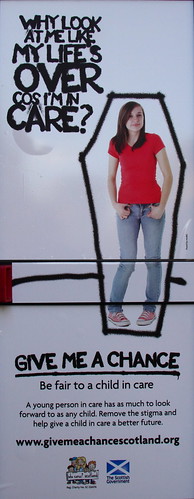 |
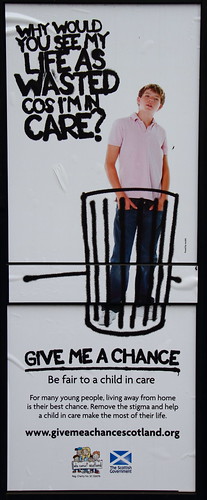 |
These kids … well, they’re models (as it says on the advertisements, just on the right, about halfway up the side of each piece, and in every other image on the campaign website), but they’re supposed to represent children “in care.” Foster care, I’d assume, not juvenile detention. Is this an issue? Do people look down upon children because their parents were awful? And how would anybody know such a thing?
I don’t know about how “care” works here, but I do know that I’d probably tend to relate to someone because of who they were, not because of who their parents were. That may be me, though, particularly because I despise nepotism, cronyism, and favoritism (where who you know definitely trumps what you know). Perhaps this is more of a problem in Scotland or the UK than in California? I have no idea, and the whole ad campaign strikes me funny.
What I find even more odd than the existence of this campaign is that the ads feel the need to point out very clearly that the people in them are not in care. How strange is that? I mean, sure, you wouldn’t want somebody to see them elsewhere and shun them … but that seems to be part of the point, isn’t it? If you’re trying to address discrimination, you’d think that pointing out these kids as good kids, paid to be in the ads, implies that 1) kids in care are not good, 2) being associated with “being in care” actually is something for which to be ashamed, and 3) you should be ashamed that we have to hide kids in care from you, lest you mistreat them. Take a look at their other images and it becomes clear: no children in care were involved.
Lastly, I leave you with some particularly strong women (this picture taken looking straight up): they’re either holding up the architecture, or they’re hanging onto it. Either way, they’ve got to have quite a bit of muscle!
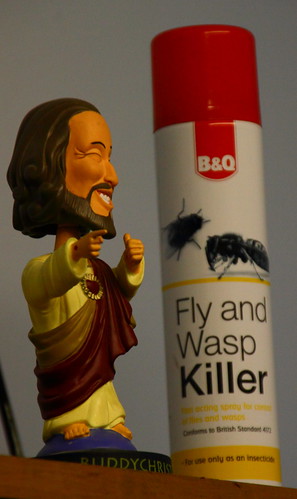
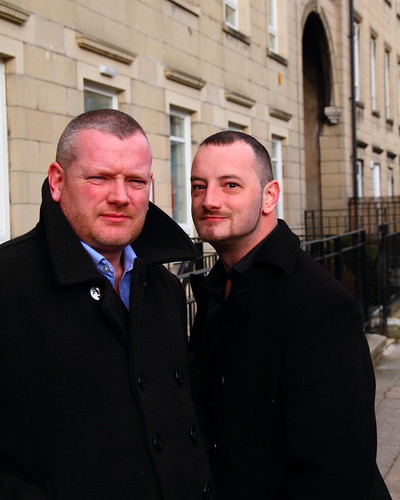
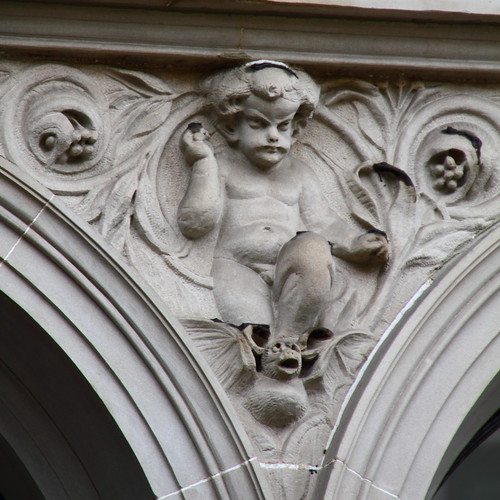
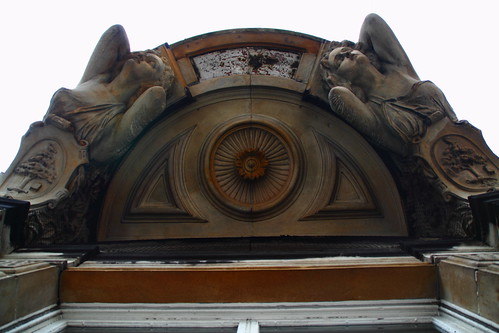
Buddy Jesus with his thumb up and the ol’ winking and finger shooting. Just what every good office needs…er, not!
Love the shields on the women.
Do you mind people asking for their pictures? Here they are also so paranoid about anything surveillance (like they aren’t using them and not realizing that cell phones are stealing others privacy…) that they duck and hide and avoid. Or just give me an annoying or lethal look. -L
Actually, it’s kind of refreshing, in a strange sort of way. I don’t usually get the suspicion, unless I’m in a park or something and there are children around – then I get the suspicion, and people edge away from me. The paranoia around here is not about adults being photographed, but about people photographing children.
Now, that said, they have something called the Data Protection Act, which limits the types of information which may be kept or collected. For photographers, this means that if it’s reasonable to obtain someone’s consent, and if they will be identifiable, you must obtain their consent. So, even if they’re in a public place, they’re protected. People take it quite seriously – overly so, in some cases. But it means that they’re aware of their rights, at least, far more so than in the US, where pictures of people in a public place are only illegal if you’re actually bothering someone by taking them – you have no right to privacy while in public, there.
You know what’s completely weird?
That the dudes wanting their pictures taken couldn’t really even be bothered to smile.
Um, okay… 🙄
Ummm…the buddy Christ…I want one…strangely enough 😕
The dudes in the picture disturb me. Who does that…ask for your picture to be taken by a complete stranger not knowing where it will end up?!?!!?
The kids in care thing is still strange for me, but I’m realizing that there’s a lot of bias in some people’s minds against foster caregivers in the U.S. — not against the kids, necessarily, although there’s some idea that people who care for them are strangely heroic, because the kids are automatically bad or troubled — but the idea that people simply care for kids for the money was a hard one for me to get used to… simply because hey, we lived with foster kids and WERE NOT WEALTHY. It takes a bit of money to feed and clothe a child, oddly enough, and everything the state gave for the kids was used …for the kids.
Assumptions abound on just about everything, I guess. But the coffin thing is …incomprehensible. Still.